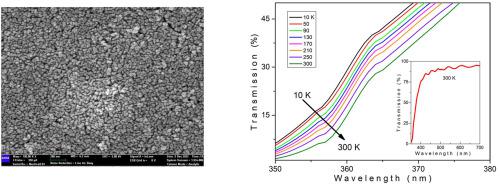Physica E: Low-dimensional Systems and Nanostructures ( IF 2.9 ) Pub Date : 2023-03-22 , DOI: 10.1016/j.physe.2023.115712 M. Isik , S. Delice , N.M. Gasanly

|
Cerium dioxide (CeO2) have been one of the attractive photocatalysts material in recent years. Band gap and its change with temperature takes remarkable attention in the photocatalytic applications. The present work reported structural and temperature-dependent band gap characteristics of the CeO2 nanoparticles on glass substrate. X-ray diffraction (XRD) pattern exhibited nine peaks related to face-centered cubic structure. Crystallite size and micro-strain of the nanoparticles were determined from the analyses of XRD peaks. Scanning electron microscope (SEM) image indicated that CeO2 is in the form of nanoparticle with almost cube shaped of diameters in between 20 and 30 nm. Transmission measurements were performed in the 350–700 nm range at various temperatures between 10 and 300 K. The analyses of the transmission spectra showed that direct band gap energy decreases from 3.35 to 3.29 eV when sample temperature was raised from 10 K to room temperature. The temperature dependence of band gap energy was analyzed by Varshni expression. The analysis presented absolute zero and rate of change of band gap with temperature as 3.35 eV and −4.7 × 10−4 eV/K, respectively.
中文翻译:

CeO2 纳米粒子光催化剂带隙的温度依赖性
二氧化铈(CeO 2 )是近年来备受关注的光催化剂材料之一。带隙及其随温度的变化在光催化应用中引起了极大的关注。目前的工作报告了玻璃基板上CeO 2纳米粒子的结构和温度依赖性带隙特性。X 射线衍射 (XRD) 图案显示出与面心立方结构相关的九个峰。从 XRD 峰的分析确定纳米颗粒的微晶尺寸和微应变。扫描电子显微镜(SEM)图像表明,CeO 2呈纳米颗粒形式,直径在 20 至 30 纳米之间,几乎呈立方体形状。在 10 和 300 K 之间的不同温度下,在 350–700 nm 范围内进行透射测量。透射光谱分析表明,当样品温度从 10 K 升高到室温时,直接带隙能量从 3.35 降低到 3.29 eV。通过 Varshni 表达式分析了带隙能量的温度依赖性。分析表明带隙的绝对零值和带隙随温度的变化率分别为 3.35 eV 和 −4.7 × 10 -4 eV/K。












































 京公网安备 11010802027423号
京公网安备 11010802027423号